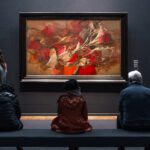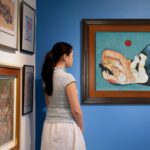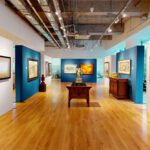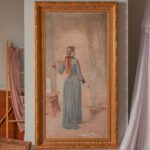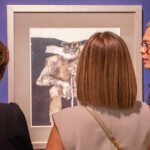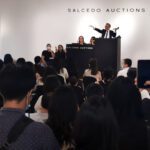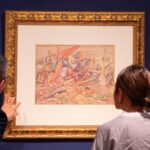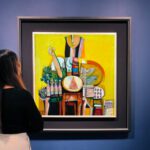”Still life is the touchstone of painting.” — Édouard Manet (1832 – 1883)
Still life painting has long been a preoccupation of artists, a chance to show off their masterful rendering skills by capturing in breathtaking detail the delicate petals of a flower, for example, or the gleaming reflection off of a brown glass beer bottle. The genre has proven limitless through the centuries. Below is a selection of works from the upcoming The Well-Appointed Life highlighting the genres fascinating breadth in terms of interpretation and execution.In National Artist Arturo Luz’s body of work, inanimate subjects appear considerably less than his painted human figures or architectural structures; which makes Madjapahit Pot & Two Boxes an incredibly rare and sought after piece that captures the quintessence of the revered abstractionist. Luz also largely worked in a palette of blacks, reds, and yellows, which makes the lot on offer — rendered in light brown, almost pinkish tones — highly prized. Executed in the same subdued manner, with pale colors that do not completely adhere to the surface, Luz reveals his deft mastery in depicting the semblance of lightness not often associated with abstract, geometric forms. This lot is consigned by no less than the late National Artist’s daughter, Luisa Luz Lansigan, who points out that this painting was one of her father’s favorites.
Among National Artist Ang Kiukok’s most recognizable still life leitmotifs is the humble potted plant positioned in front of a window. His mastery of semi-figurative abstraction is evident in his fragmentation of the plant, still made life-like and dynamic by the work’s vibrant hues and undulating lines. His visualization and stylized interpretation of reality and his subjects, even at their most mundane, continues to draw audiences in, just like the window, which allows viewers to take a look inside. This work has sterling provenance, having been acquired from the artist circa 1975 by Renato ‘Butch’ Santos of Prudential Bank. The work was exhibited together with other similarly sized works by Ang Kiukok for a show at the now defunct Arts and Associates Gallery, before being sold by Santos to the current owner.
Ang’s modernist visualizations of still life paintings elevates the ordinary into the extraordinary by rendering everyday objects in his iconic, semi-figurative cubist style. The lot on offer, simply titled ‘Watermelon,’ serves as a fine example of his still life oeuvres — laid out on a tabletop are watermelon slices, the painting rendered in vibrant shades of primary colors. During his distinguished career, Ang learned to incorporate multiple viewpoints in his work, allowing him to reduce his subject to their most basic, geometric silhouettes while still staying true to reality.
Belonging to a relatively early series by the celebrated abstractionist, Ang Kiukok’s ‘Bananas’ emerged during a strong surge of modernism in the Philippine visual art scene spanning the 50s to 60s. This work together with the following lot from the same series come from a 1957 exhibition at the legendary Philippine Art Gallery (PAG), and both still bear the exhibition label from the time. They were acquired by the late Rufus Colefax Phillips III who was a Yale graduated CIA recruit, and later USAID official who spent time in Vietnam and made frequent visits to the Philippines, where he befriended President Ramon Magsaysay.
The lot on offer, which according to the painting’s owner, Peter Soriano, who is a recognized expert on the artist, is listed in Fernando Zóbel’s catalogue raisonné as his very first work, is a bodegón (still life) clearly reminiscent of Van Gogh’s early still lifes — the Dutch post-impressionist being known as an early artistic influence. Painted in 1948, the artwork was completed during the artist’s years at Harvard University, and is appreciated as the artist’s earliest recorded figurative painting as opposed to his later graphic works.
National Artist Federico Aguilar Alcuaz is revered by generations of artists. Celebrated art historian and critic Dr. Rod Paras-Perez even referred to Alcuaz as an “epic troubadour of the urban landscape.” Particularly famous are his works depicting Manila and Barcelona, the former the land of his birth and later years, and the other where his artistic career germinated and thrived for many decades. His years in Francoist Spain, particularly during the period when Spanish abstract art was also flourishing, had a profound impact on his style. This Western graphic influence is clearly seen in this painting, as is the strong gestural and calligraphic effect of another emerging Spanish artist at the time, Antonio Saura. Alcuaz uses visual devices to mimic a sense of dimensionality. What would usually be a still life, is transformed into a feeling of curiosity of what the image could become – the perfect metaphor for a burgeoning artistic journey at the cusp of greatness.
Emmanuel Garibay is a contemporary Filipino artist whose work has been exhibited in Europe, Asia, and the United States. In 2000, he received the prestigious Thirteen Artists Award from the Cultural Center of the Philippines. Be it from the mundane and quotidian to grand and monumental, Garibay’s paintings are works of passion, portraying a rawness that flows through the skin and permeates the gesture of his subjects, highlighting his prowess in figuration.
‘The Well-Appointed Life’ live and online auction takes place live and online on Saturday, 17 September, 2022 at 2PM. Click here to view the catalogue. * The auction preview runs daily from 9AM-5PM at NEX Tower, 6786 Ayala Avenue, Makati City. For inquiries, email [email protected] or phone +632 8 8230956 | +63 917 591 2191. Follow @salcedoauctions on Instagram and Facebook for updates.








